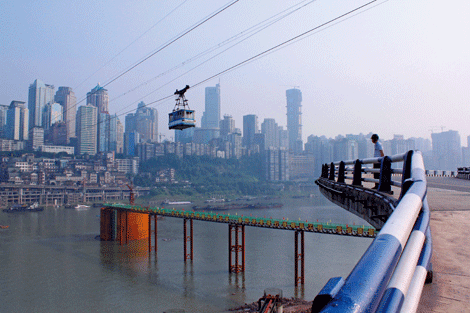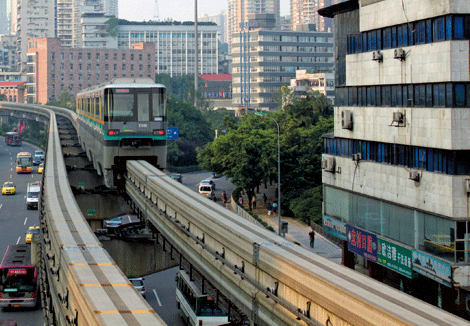Chongqing may have only recently appeared on the map of global interest due to a particularly dramatic scandal, but its sheer size really should have had people talking much earlier. It is one of the biggest cities in the world, with the population of its extended municipal area estimated at anything from 25-32 million – a number greater than all the people in Beijing and Shanghai combined. Along with those two cities and Tianjin it enjoys provincial-level status. In total, it covers an area of about 82,400sq km. It is the largest industrial city in southwest China, and a hub for communications and automobile and computer manufacture. Suzuki, Ford and Mazda are all based here, and the gargantuan city produces a third of the world’s computers. It is also a main transportation hub for the region.

Chongqing is situated at the confluence of the Yangtze and Jialing rivers, and therefore has attracted waves of immigrants for millennia. Tourism is a growing industry here, with the picturesque Three Gorges area being the main attraction. Many of the city’s older streets are lined with banyan trees, which according to locals symbolise a strong life.
Chongqing has plenty of nicknames, from the rather unflattering “Foggy City” and “Furnace City” – reflecting the air quality and climate – to the kinder “Mountain City” and “City of the Artists”, because of its hilly terrain and the fact that the Sichuan Fine Arts Institute is located here. The latter is a reflection of how traditional painting and sculpture is an important part of the city’s culture.
On arrival
Chongqing Jiangbei International Airport (CKG) is some 20km north of the city. The facility opened on January 22 in 1990 and is designed to handle 15 million passengers per year as well as wide-body aircraft such as B747s and A340s. According to the airport’s website, its passenger traffic surpassed 14 million in 2009, securing its place as one of China’s 10 busiest airports and among the top 100 in the world. Upgrade works are under way to increase the airport’s capacity to 30 million passengers annually.
The efforts seem to have paid off. It was named Asia’s “most improved” airport by Airport Service Quality Awards, organised by the non-profit Airports Council International based on passenger satisfaction. Its international connectivity has also expanded, with the newest airlines serving it including Finnair, SilkAir and Qatar Airways.

Orientation
Getting your bearings can be a challenge in this mega-metropolis. But a good place to orientate yourself is Chaotianmen Gate, which lies at the confluence of the Yangtze and Jialing rivers on the southeastern tip of the Chongqing Peninsula, referred to by many who live here as “the island”.
Unlike most cities in China, historically bicycling has never been popular in Chongqing due to its hilly terrain. This has ensured that a well-developed public transport network has evolved over the years. The yellow taxis are all locally made and fares are reasonable. Chongqing’s monorail also opened in July 2011 and is currently 96km long. This and the subway are an efficient and relatively easy way to traverse the dense network of streets in the sprawling urban landscape.
Where to stay
For a city of this size, Chongqing is playing catch-up with hotels of international standard. The following are a few recognised brands that have entered the market.
JW Marriott Hotel Chongqing
This elegant 369-room property is located in the centre of the main shopping and commercial district. Gastronomically it is well equipped, with a steakhouse, as well as Japanese and Chinese restaurants. These outlets are favoured by locals as well. www.marriott.com
Sheraton Chongqing Hotel
Opened in September 2011, this decadent property has ceiling frescoes, a waterfall in the reception and lashes of gold paint on the interiors. Many of the 404 rooms have views of the Yangtze River, and another attached tower houses office and retail spaces. www.starwoodhotels.com
Doubletree by Hilton Hotel Chongqing North
Located in Guanyinqiao, one of Chongqing’s main commercial streets, and next to Bei Cheng Tian Jie (Paradise Walk), this property is within minutes of shops, malls, street cafés, restaurants and entertainment. It has 284 rooms, an all-day dining restaurant, lobby bar, executive lounge, health club and spa. www.chongqingnorth.doubletree.com
Hyatt Regency Chongqing
This hotel’s 321 well-appointed guestrooms and suites mostly enjoy panoramic views of Paradise Walk. This property is part of a mixed-use development that combines shopping, offices and various dining and entertainment experiences. Transportation links around the hotel are convenient. The hotel also features five innovative food and beverage outlets. www.hyatt.com
Where to eat and shop
Ciqikou Old Town
Ciqikou is over 1,000 years old and features restored buildings that make for a pleasant walk. Behind the shops and restaurants there is still an authentic community going about life as they always have done. Here you will find craft and souvenir shops selling traditional Chinese paintings and calligraphy as well as Sichuan embroidery. There are 12 lanes that feature both Ming and Qing dynasty architectural styles.
Little teahouses and street stalls offer up lots of local food and snacks, including the fried dough twist named mahua (about RMB15/US$2.37 per bag), chuanbei liangfen (clear noodles in chilli sauce) at just RMB3 (US$0.47) a bowl, jiaoyan huasheng (spicy fried peanuts) costing RMB5 (US$0.78) for a small bag, and, if you are feeling brave, spicy duck blood hot pot, or mao xuewang, which will set you back about RMB40 (US$6.30) per person. This is also a good place to enjoy some Sichuan Opera, often performed near the Yangtze River. Tickets cost RMB20 (US$3.16) per person and the show is best enjoyed with the traditional Chongqing tea, tuocha. The Ciqikou Temple Fair attracts hundred of thousands of visitors during the Chinese Spring Festival.
Hot Pot
Chongqing’s culinary pride and joy is undoubtedly the hot pot – a dish that is said to have originated here. It consists of a pot which usually has two stocks separated by a wavy divider – a yin and yang. One is spicy and clear, the other not so, and this is said to echo the rivers as they meet at this point, the Yangtze being cloudy, the Jialing being clearer. There are numerous places to enjoy this local favourite, and many supermarkets even sell hot pot ingredient packets for you to try your hand at re-creating the experience at home. While in Chongqing however, ask your hotel concierge for a restaurant recommendation, or try Wai Po Qiao Hotpot (L707-709, 7/F Metropolitan Plaza, 68 Zou Rong Lu, Yuzhong District, tel +86 23 6383 5988, open 10am-10pm), where all you can eat costs RMB68 (about US$10).
Paradise Walk and Guanyingqiao
As with many metropolises in modern China, materialism is à la mode, and Chongqing is no exception. There are a variety of offerings that nourish the consumerist climate and make for an interesting, and often fruitful, browse. Paradise Walk, or Bei Cheng Tian Jie, is a vast pedestrianised street that offers shopping as well as dining and entertainment. Guanyinqiao is another such street, which provides for both those looking for international luxury brands and bargain hunters searching for trinkets from stalls.
Where to unwind
Chongqing Planning Exhibition
Heading into a nearby exhibition centre to see plans for the city may seem a very uninteresting idea, but rest assured it isn’t. If you harbour any doubts about the ambition of the Chinese when it comes to infrastructure, and the level of planning that has gone into what has already been built, the Chongqing Planning Exhibition will dispel it. It lays out the municipal government’s vision for 2020, with a 900 sqm model mapping out not only the city, but the other towns in the municipality – and if you think Chongqing is big now, just wait to see what is planned. The model is excellent and shows the varied geography of Chongqing municipality, and also just how hilly it is. Open Tuesday to Sunday, 9am-3.30pm, entrance fee RMB5 (US$0.79), English tours are at 10am and 3pm and cost RMB300 (US$48). www.cqghzlg.gov.cn
Nanbin Road
Another good place to relax and unwind is this 25km-long road, which features an urban park and river view, providing a welcome – if thin – slice of nature, albeit flanked by hectic city lights. There are also many dining and entertainment options here, and during the Chinese Spring Festival there is a big fireworks display at this location.
Jeifangbei
When it comes to nightlife, Jeifangbei is the city’s “club street” and is the happening area to be in. Particular hotspots include No 88, Baby Face, Soho, Cotton, Deyi World and the bars in Hongya Cave. Chongqing Tiandi also contains popular, more upscale bars such as Dancing with the Sharks and Somewhere Bar. www.cqtiandi.com








